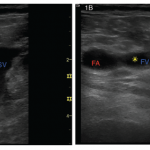
Kateryna Kon / shutterstock.com
When patients with lupus are hospitalized, they should be screened and likely treated for venous thromboembolism, researchers of a nationwide study say.
In May, ACR Open Rheumatology published results of the large retrospective study spanning several years. Researchers analyzed trends in mortality, morbidity and hospitalization from venous thromboembolism (VTE), specifically among patients diagnosed with systemic lupus erythematosus (SLE). The results showed hospitalized lupus patients with thromboembolism had more than two times the risk of dying as those without VTE, and thromboembolism was identified as an independent risk factor for mortality in these patients.
The findings underline the importance of proper screening and implementation of prophylactic anticoagulation for this patient population, says study author Shweta Kishore, MD, an assistant professor in the Division of Rheumatology at the University of Mississippi Medical Center (UMMC), Jackson.
Venous thromboembolism is the third leading vascular diagnosis after heart attack and stroke, according to the American Heart Association. Previous cohort studies have demonstrated the risk of VTE is higher among patients who have lupus, especially in people with antiphospholipid antibodies that increase the risk of excessive blood clotting, according to the authors. This study sought to address a lack of data on how these patients fare during and after hospital stays.
“What we wanted to see is [whether] this affects their mortality [and] other hospital outcomes, such as the cost of hospitalization, the length of stay and their disability status at the time of discharge,” Dr. Kishore says.
The Study
Researchers reviewed the Nationwide Inpatient Sample (NIS) database from 2003–2011 to track the study’s primary endpoints of inpatient mortality, hospitalization trends and inpatient mortality rate. They also identified secondary outcomes of hospital length of stay and cost, as well as level of disability at discharge.
Patients were included in the study if they were 18 or older and had a diagnosis of SLE and VTE. Only patients with VTE as one of the top three discharge diagnoses were included in the cohort, while those with superficial thrombosis were excluded. Out of nearly 300,000 patients in the study who were hospitalized with SLE, 9,175 (3.06%) also had VTE and, compared with patients without VTE, suffered significantly higher inpatient mortality at a rate of 5% vs. 2.0% (odds ratio [OR] of 2.35 [95% confidence interval (CI) 2.10–2.62]; P<0.001). The same group also had greater disability at discharge (34% vs. 26%; OR of 1.53 [95% CI 1.46–1.62]; P<0.001) after longer, costlier hospital stays.
“Our study is the largest retrospective analysis of a national discharge database” to study this population, says Dr. Kishore. “What we found in our study is that the patients who had a discharge diagnosis of thromboembolism had a much higher inpatient mortality rate as compared to the patients who did not have venous thromboembolism. They had a greater [level of] disability at discharge. Their hospitalization cost was higher by $25,000 for each hospitalization, and they stayed in the hospital longer by 3.57 days.”
Additional analysis of the database indicates that being African American was associated with increased risk of VTE, as was being male and younger, possibly because men with lupus tend to have severe forms of the disease, according to the authors.
The study’s senior author, Vikas Majithia, MD, MPH, a UMMC professor of medicine and chief and fellowship program director of rheumatology, says it was interesting that there were no differences between urban and rural hospitals.
“In this sample, there was no difference, and the same was true whether these patients were admitted to a teaching or non-teaching hospital,” he says. “This study did not show disparity [by] geography or teaching status of the hospitals. But that does not mean that it doesn’t exist.”



